Fangjinhua Wang
Open-Vocabulary Functional 3D Scene Graphs for Real-World Indoor Spaces
Mar 24, 2025Abstract:We introduce the task of predicting functional 3D scene graphs for real-world indoor environments from posed RGB-D images. Unlike traditional 3D scene graphs that focus on spatial relationships of objects, functional 3D scene graphs capture objects, interactive elements, and their functional relationships. Due to the lack of training data, we leverage foundation models, including visual language models (VLMs) and large language models (LLMs), to encode functional knowledge. We evaluate our approach on an extended SceneFun3D dataset and a newly collected dataset, FunGraph3D, both annotated with functional 3D scene graphs. Our method significantly outperforms adapted baselines, including Open3DSG and ConceptGraph, demonstrating its effectiveness in modeling complex scene functionalities. We also demonstrate downstream applications such as 3D question answering and robotic manipulation using functional 3D scene graphs. See our project page at https://openfungraph.github.io
R-SCoRe: Revisiting Scene Coordinate Regression for Robust Large-Scale Visual Localization
Jan 02, 2025



Abstract:Learning-based visual localization methods that use scene coordinate regression (SCR) offer the advantage of smaller map sizes. However, on datasets with complex illumination changes or image-level ambiguities, it remains a less robust alternative to feature matching methods. This work aims to close the gap. We introduce a covisibility graph-based global encoding learning and data augmentation strategy, along with a depth-adjusted reprojection loss to facilitate implicit triangulation. Additionally, we revisit the network architecture and local feature extraction module. Our method achieves state-of-the-art on challenging large-scale datasets without relying on network ensembles or 3D supervision. On Aachen Day-Night, we are 10$\times$ more accurate than previous SCR methods with similar map sizes and require at least 5$\times$ smaller map sizes than any other SCR method while still delivering superior accuracy. Code will be available at: https://github.com/cvg/scrstudio .
DepthSplat: Connecting Gaussian Splatting and Depth
Oct 17, 2024



Abstract:Gaussian splatting and single/multi-view depth estimation are typically studied in isolation. In this paper, we present DepthSplat to connect Gaussian splatting and depth estimation and study their interactions. More specifically, we first contribute a robust multi-view depth model by leveraging pre-trained monocular depth features, leading to high-quality feed-forward 3D Gaussian splatting reconstructions. We also show that Gaussian splatting can serve as an unsupervised pre-training objective for learning powerful depth models from large-scale unlabelled datasets. We validate the synergy between Gaussian splatting and depth estimation through extensive ablation and cross-task transfer experiments. Our DepthSplat achieves state-of-the-art performance on ScanNet, RealEstate10K and DL3DV datasets in terms of both depth estimation and novel view synthesis, demonstrating the mutual benefits of connecting both tasks. Our code, models, and video results are available at https://haofeixu.github.io/depthsplat/.
Learning-based Multi-View Stereo: A Survey
Aug 27, 2024



Abstract:3D reconstruction aims to recover the dense 3D structure of a scene. It plays an essential role in various applications such as Augmented/Virtual Reality (AR/VR), autonomous driving and robotics. Leveraging multiple views of a scene captured from different viewpoints, Multi-View Stereo (MVS) algorithms synthesize a comprehensive 3D representation, enabling precise reconstruction in complex environments. Due to its efficiency and effectiveness, MVS has become a pivotal method for image-based 3D reconstruction. Recently, with the success of deep learning, many learning-based MVS methods have been proposed, achieving impressive performance against traditional methods. We categorize these learning-based methods as: depth map-based, voxel-based, NeRF-based, 3D Gaussian Splatting-based, and large feed-forward methods. Among these, we focus significantly on depth map-based methods, which are the main family of MVS due to their conciseness, flexibility and scalability. In this survey, we provide a comprehensive review of the literature at the time of this writing. We investigate these learning-based methods, summarize their performances on popular benchmarks, and discuss promising future research directions in this area.
GLACE: Global Local Accelerated Coordinate Encoding
Jun 06, 2024Abstract:Scene coordinate regression (SCR) methods are a family of visual localization methods that directly regress 2D-3D matches for camera pose estimation. They are effective in small-scale scenes but face significant challenges in large-scale scenes that are further amplified in the absence of ground truth 3D point clouds for supervision. Here, the model can only rely on reprojection constraints and needs to implicitly triangulate the points. The challenges stem from a fundamental dilemma: The network has to be invariant to observations of the same landmark at different viewpoints and lighting conditions, etc., but at the same time discriminate unrelated but similar observations. The latter becomes more relevant and severe in larger scenes. In this work, we tackle this problem by introducing the concept of co-visibility to the network. We propose GLACE, which integrates pre-trained global and local encodings and enables SCR to scale to large scenes with only a single small-sized network. Specifically, we propose a novel feature diffusion technique that implicitly groups the reprojection constraints with co-visibility and avoids overfitting to trivial solutions. Additionally, our position decoder parameterizes the output positions for large-scale scenes more effectively. Without using 3D models or depth maps for supervision, our method achieves state-of-the-art results on large-scale scenes with a low-map-size model. On Cambridge landmarks, with a single model, we achieve 17% lower median position error than Poker, the ensemble variant of the state-of-the-art SCR method ACE. Code is available at: https://github.com/cvg/glace.
UniSDF: Unifying Neural Representations for High-Fidelity 3D Reconstruction of Complex Scenes with Reflections
Dec 20, 2023Abstract:Neural 3D scene representations have shown great potential for 3D reconstruction from 2D images. However, reconstructing real-world captures of complex scenes still remains a challenge. Existing generic 3D reconstruction methods often struggle to represent fine geometric details and do not adequately model reflective surfaces of large-scale scenes. Techniques that explicitly focus on reflective surfaces can model complex and detailed reflections by exploiting better reflection parameterizations. However, we observe that these methods are often not robust in real unbounded scenarios where non-reflective as well as reflective components are present. In this work, we propose UniSDF, a general purpose 3D reconstruction method that can reconstruct large complex scenes with reflections. We investigate both view-based as well as reflection-based color prediction parameterization techniques and find that explicitly blending these representations in 3D space enables reconstruction of surfaces that are more geometrically accurate, especially for reflective surfaces. We further combine this representation with a multi-resolution grid backbone that is trained in a coarse-to-fine manner, enabling faster reconstructions than prior methods. Extensive experiments on object-level datasets DTU, Shiny Blender as well as unbounded datasets Mip-NeRF 360 and Ref-NeRF real demonstrate that our method is able to robustly reconstruct complex large-scale scenes with fine details and reflective surfaces. Please see our project page at https://fangjinhuawang.github.io/UniSDF.
VolRecon: Volume Rendering of Signed Ray Distance Functions for Generalizable Multi-View Reconstruction
Dec 15, 2022



Abstract:With the success of neural volume rendering in novel view synthesis, neural implicit reconstruction with volume rendering has become popular. However, most methods optimize per-scene functions and are unable to generalize to novel scenes. We introduce VolRecon, a generalizable implicit reconstruction method with Signed Ray Distance Function (SRDF). To reconstruct with fine details and little noise, we combine projection features, aggregated from multi-view features with a view transformer, and volume features interpolated from a coarse global feature volume. A ray transformer computes SRDF values of all the samples along a ray to estimate the surface location, which are used for volume rendering of color and depth. Extensive experiments on DTU and ETH3D demonstrate the effectiveness and generalization ability of our method. On DTU, our method outperforms SparseNeuS by about 30% in sparse view reconstruction and achieves comparable quality as MVSNet in full view reconstruction. Besides, our method shows good generalization ability on the large-scale ETH3D benchmark. Project page: https://fangjinhuawang.github.io/VolRecon.
3D Textured Shape Recovery with Learned Geometric Priors
Sep 07, 2022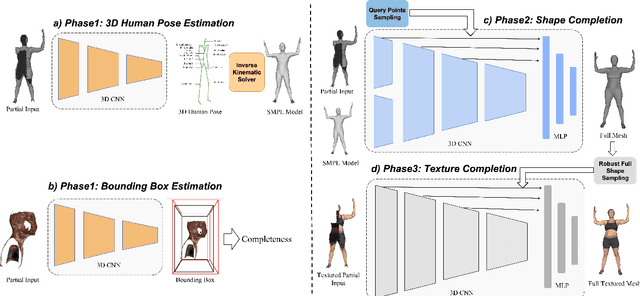
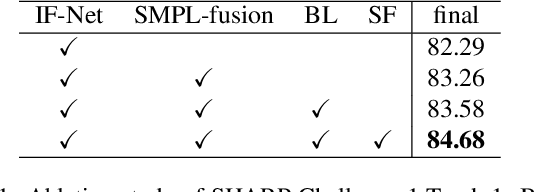
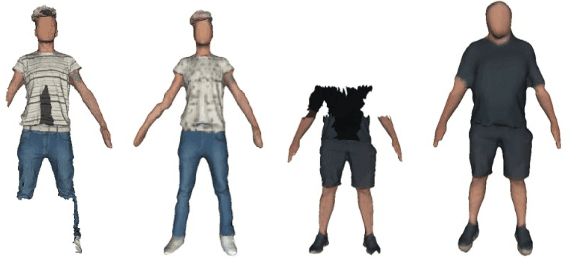

Abstract:3D textured shape recovery from partial scans is crucial for many real-world applications. Existing approaches have demonstrated the efficacy of implicit function representation, but they suffer from partial inputs with severe occlusions and varying object types, which greatly hinders their application value in the real world. This technical report presents our approach to address these limitations by incorporating learned geometric priors. To this end, we generate a SMPL model from learned pose prediction and fuse it into the partial input to add prior knowledge of human bodies. We also propose a novel completeness-aware bounding box adaptation for handling different levels of scales and partialness of partial scans.
IterMVS: Iterative Probability Estimation for Efficient Multi-View Stereo
Dec 09, 2021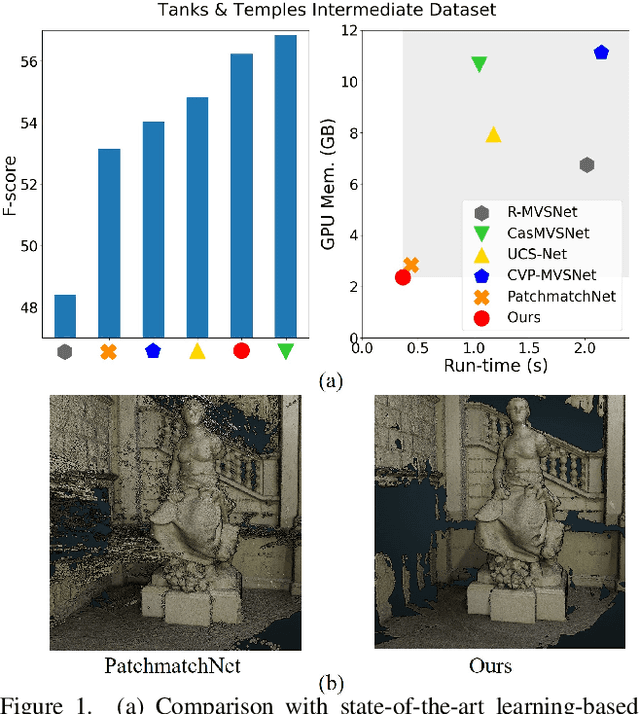
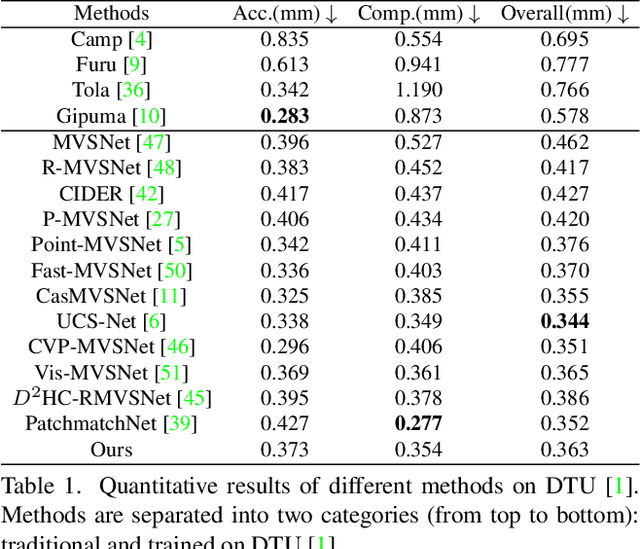
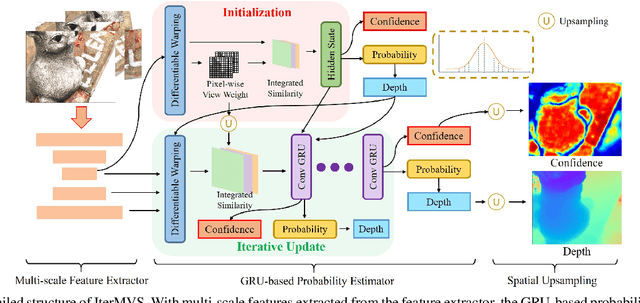
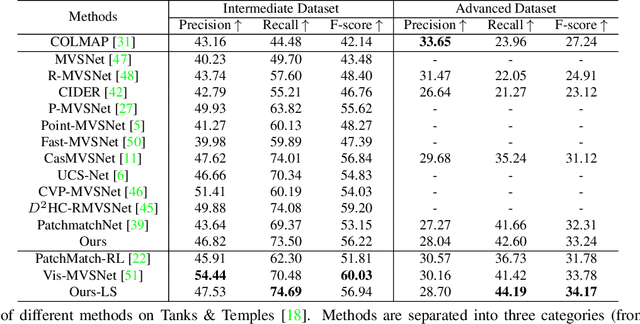
Abstract:We present IterMVS, a new data-driven method for high-resolution multi-view stereo. We propose a novel GRU-based estimator that encodes pixel-wise probability distributions of depth in its hidden state. Ingesting multi-scale matching information, our model refines these distributions over multiple iterations and infers depth and confidence. To extract the depth maps, we combine traditional classification and regression in a novel manner. We verify the efficiency and effectiveness of our method on DTU, Tanks&Temples and ETH3D. While being the most efficient method in both memory and run-time, our model achieves competitive performance on DTU and better generalization ability on Tanks&Temples as well as ETH3D than most state-of-the-art methods. Code is available at https://github.com/FangjinhuaWang/IterMVS.
PatchmatchNet: Learned Multi-View Patchmatch Stereo
Dec 02, 2020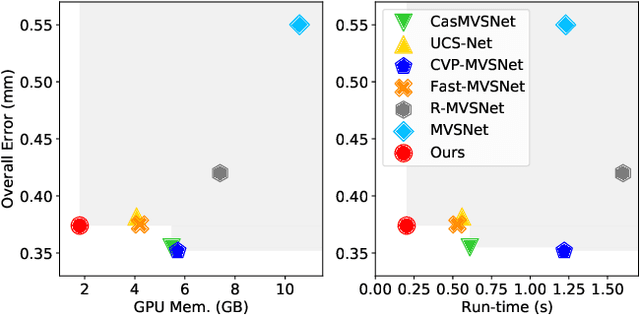
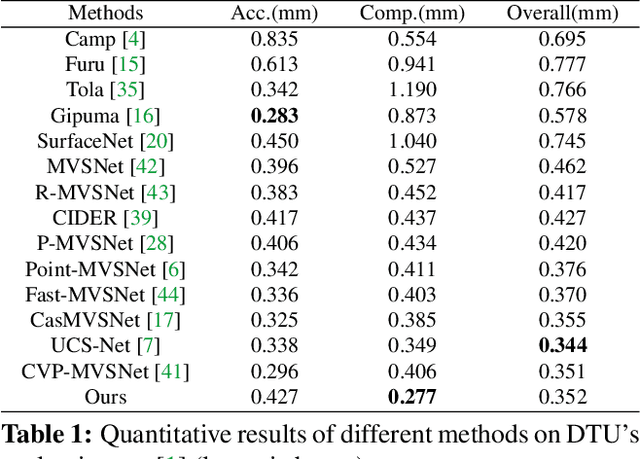
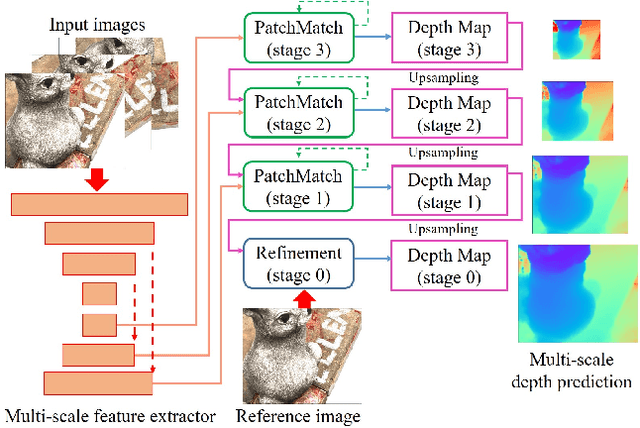
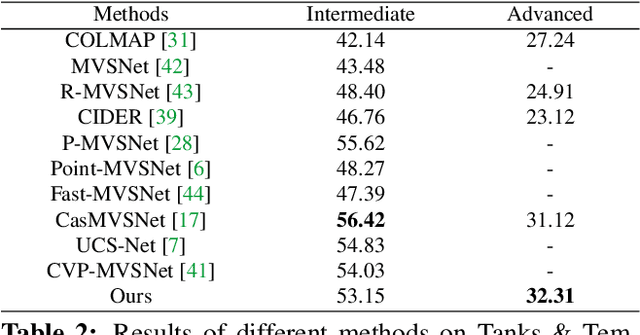
Abstract:We present PatchmatchNet, a novel and learnable cascade formulation of Patchmatch for high-resolution multi-view stereo. With high computation speed and low memory requirement, PatchmatchNet can process higher resolution imagery and is more suited to run on resource limited devices than competitors that employ 3D cost volume regularization. For the first time we introduce an iterative multi-scale Patchmatch in an end-to-end trainable architecture and improve the Patchmatch core algorithm with a novel and learned adaptive propagation and evaluation scheme for each iteration. Extensive experiments show a very competitive performance and generalization for our method on DTU, Tanks & Temples and ETH3D, but at a significantly higher efficiency than all existing top-performing models: at least two and a half times faster than state-of-the-art methods with twice less memory usage.
 Add to Chrome
Add to Chrome Add to Firefox
Add to Firefox Add to Edge
Add to Edge